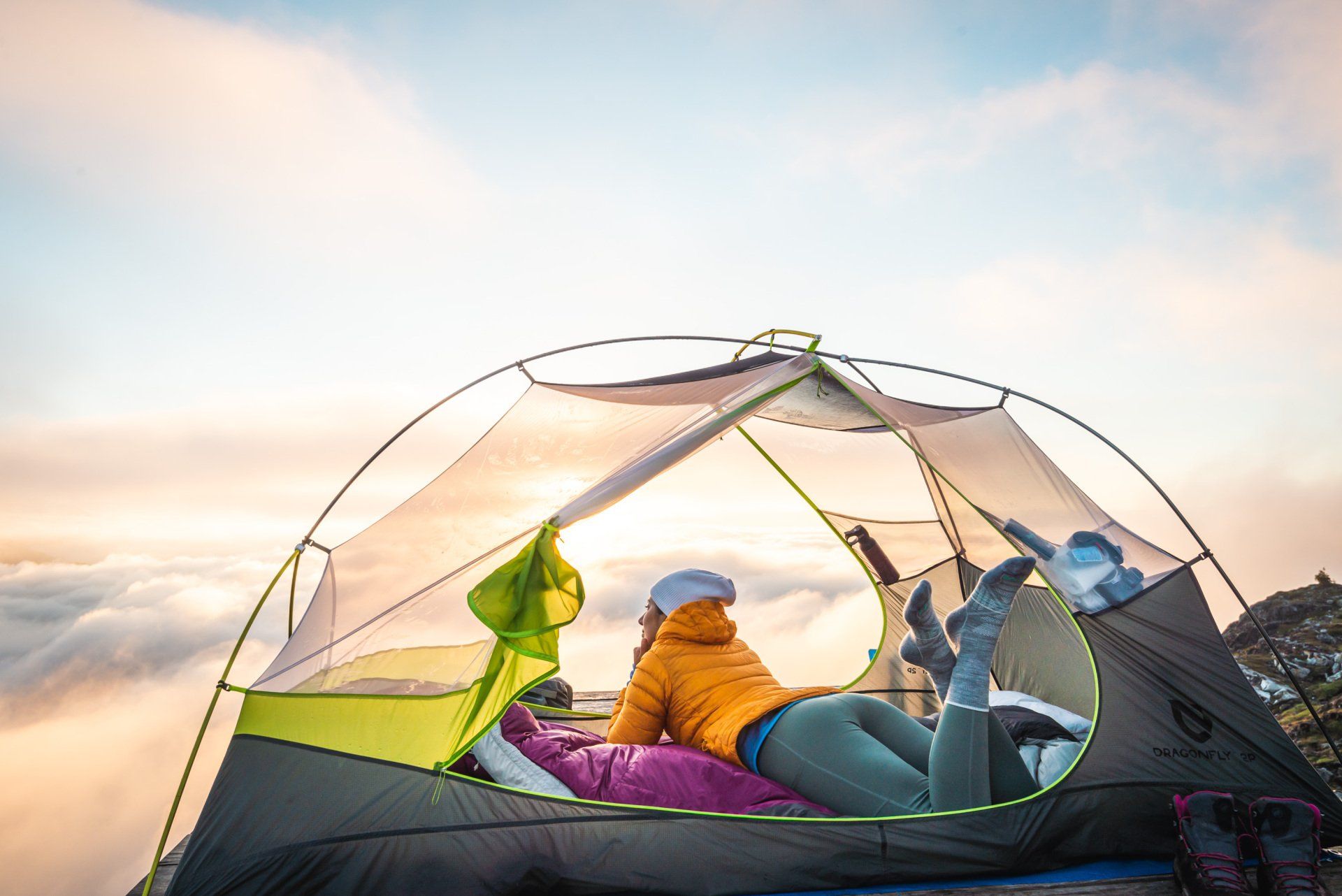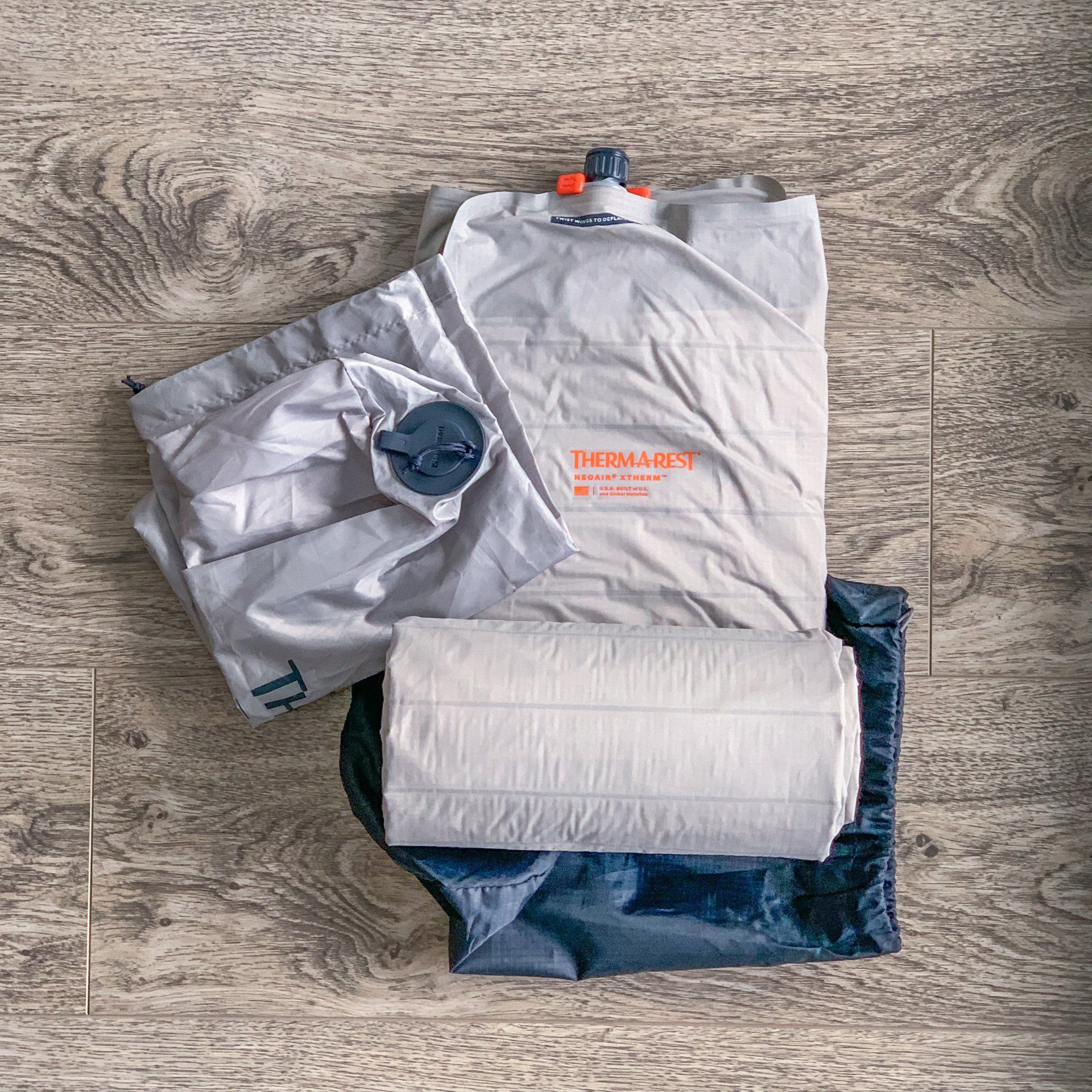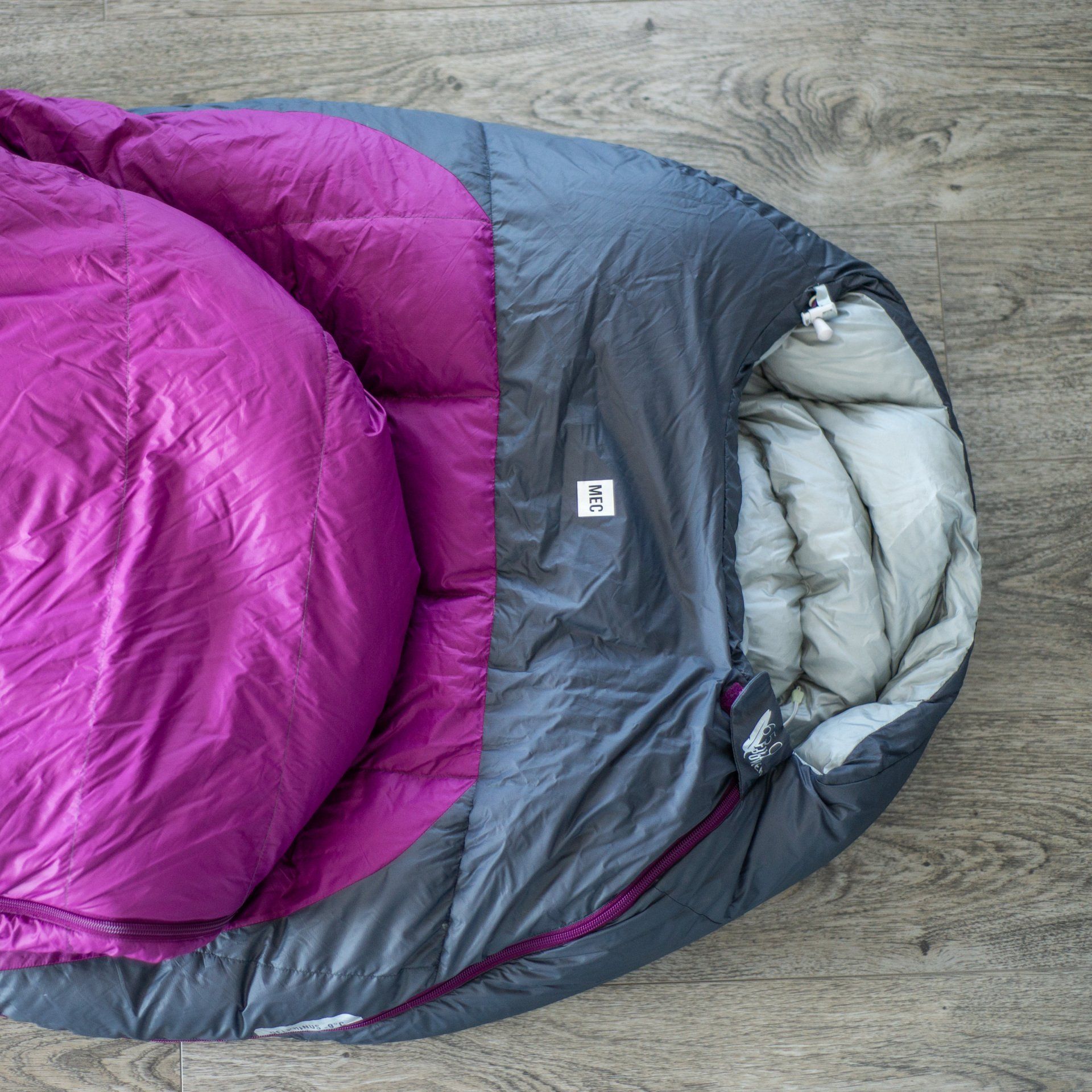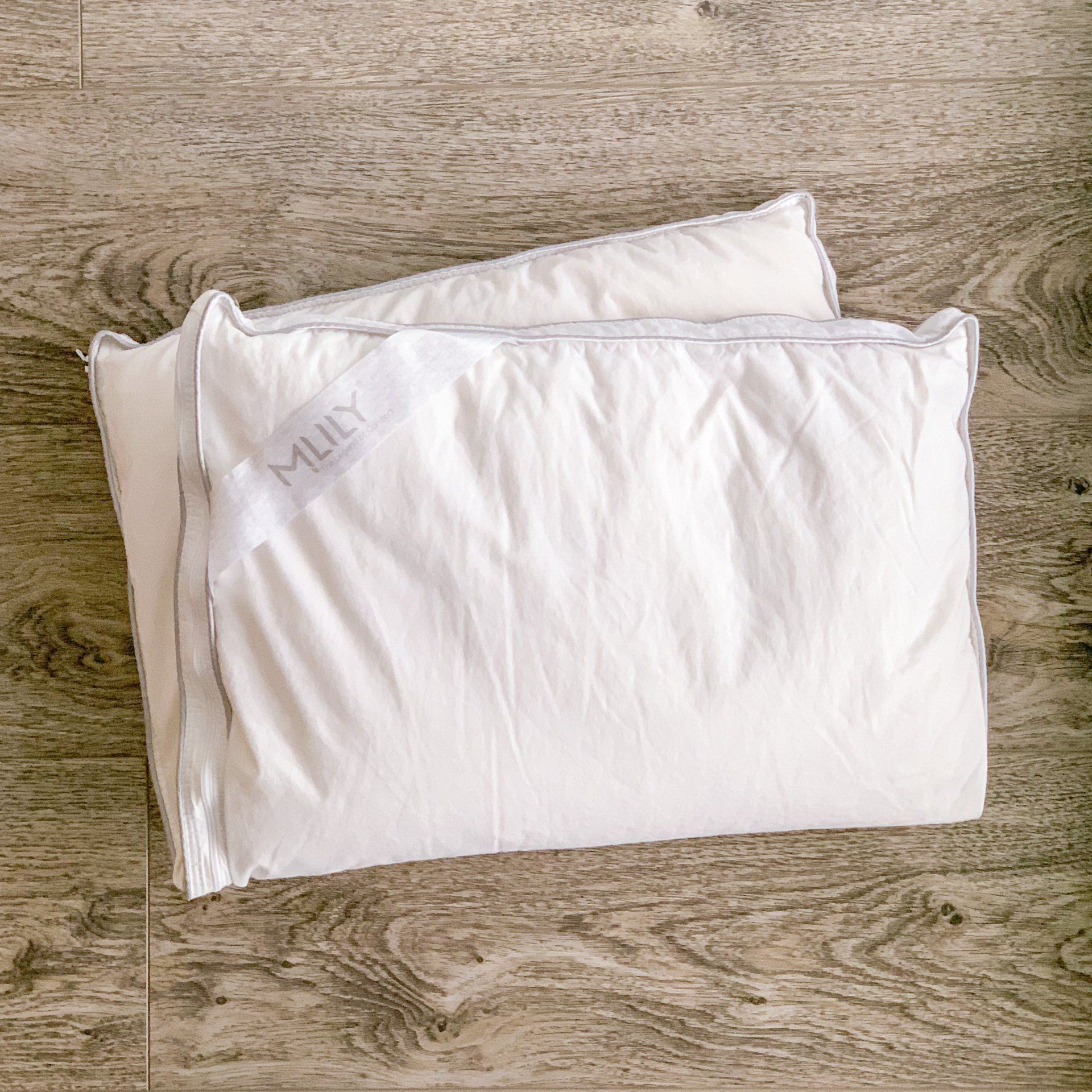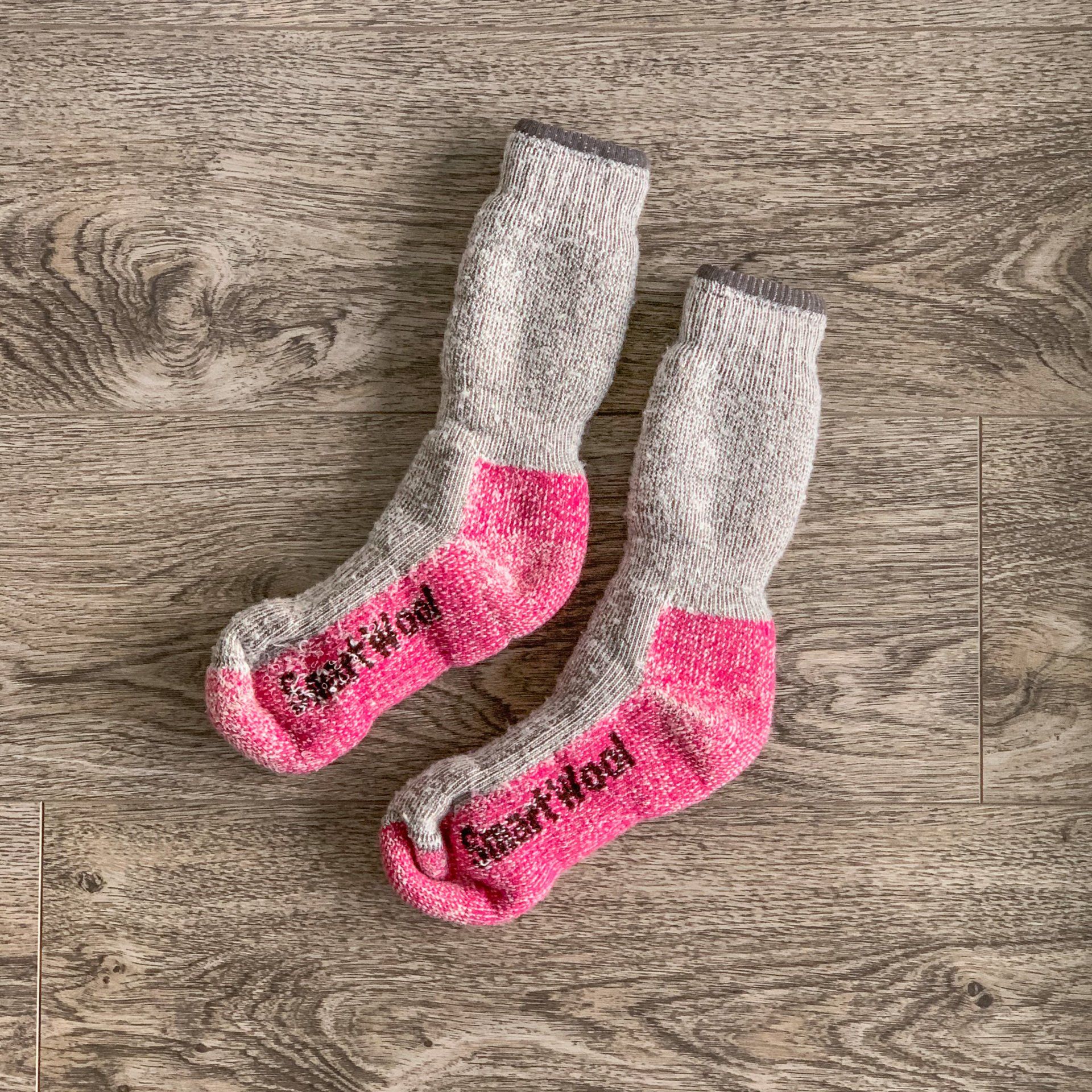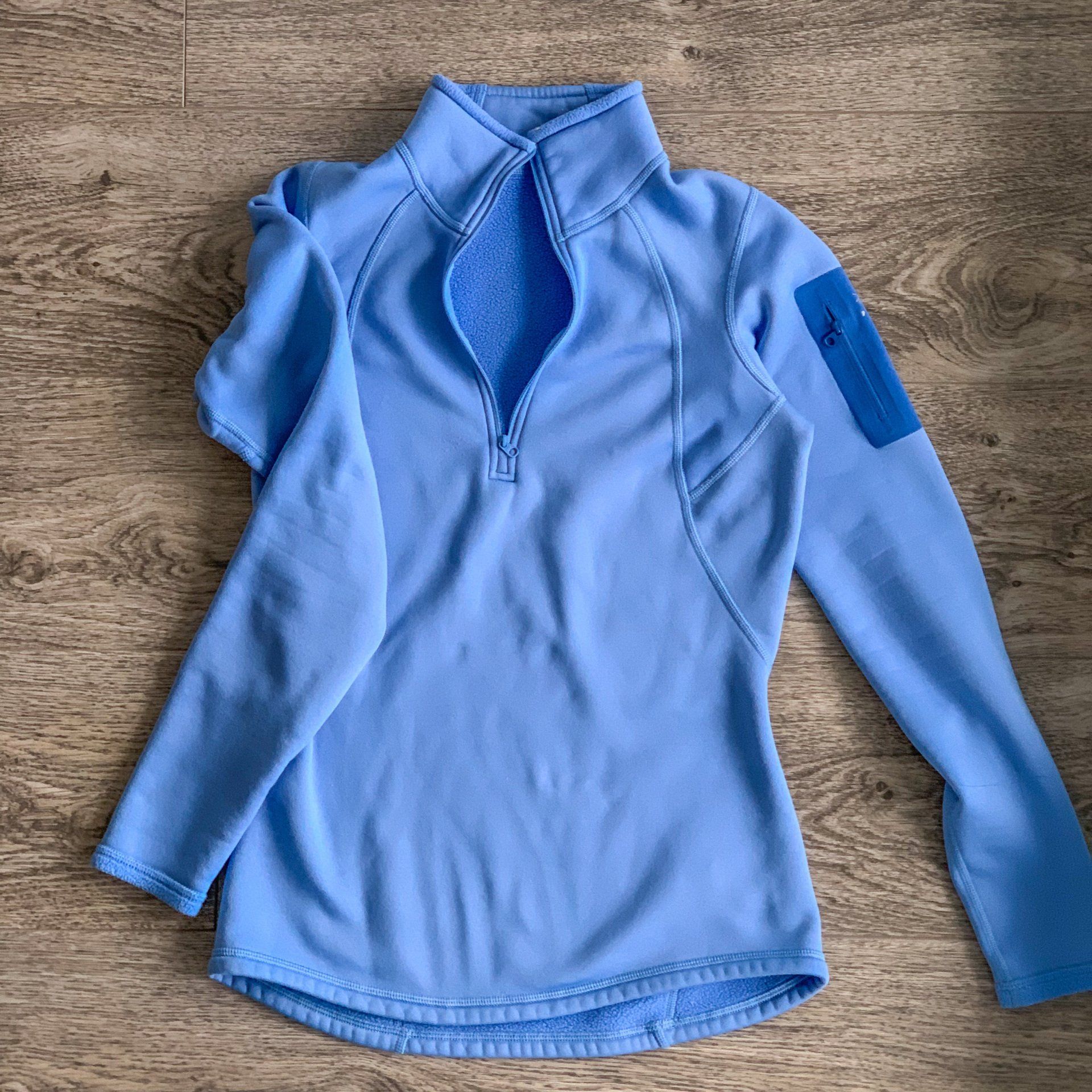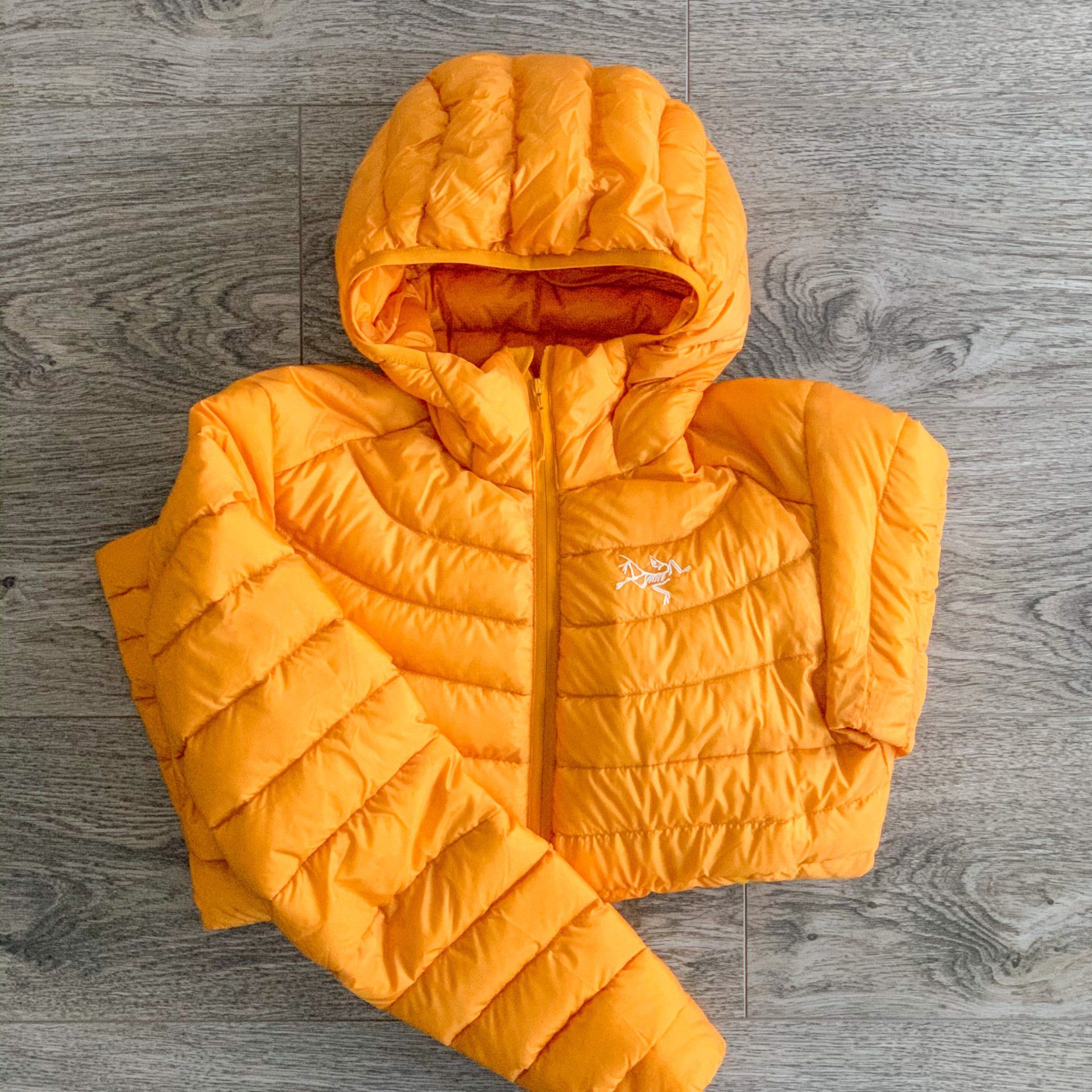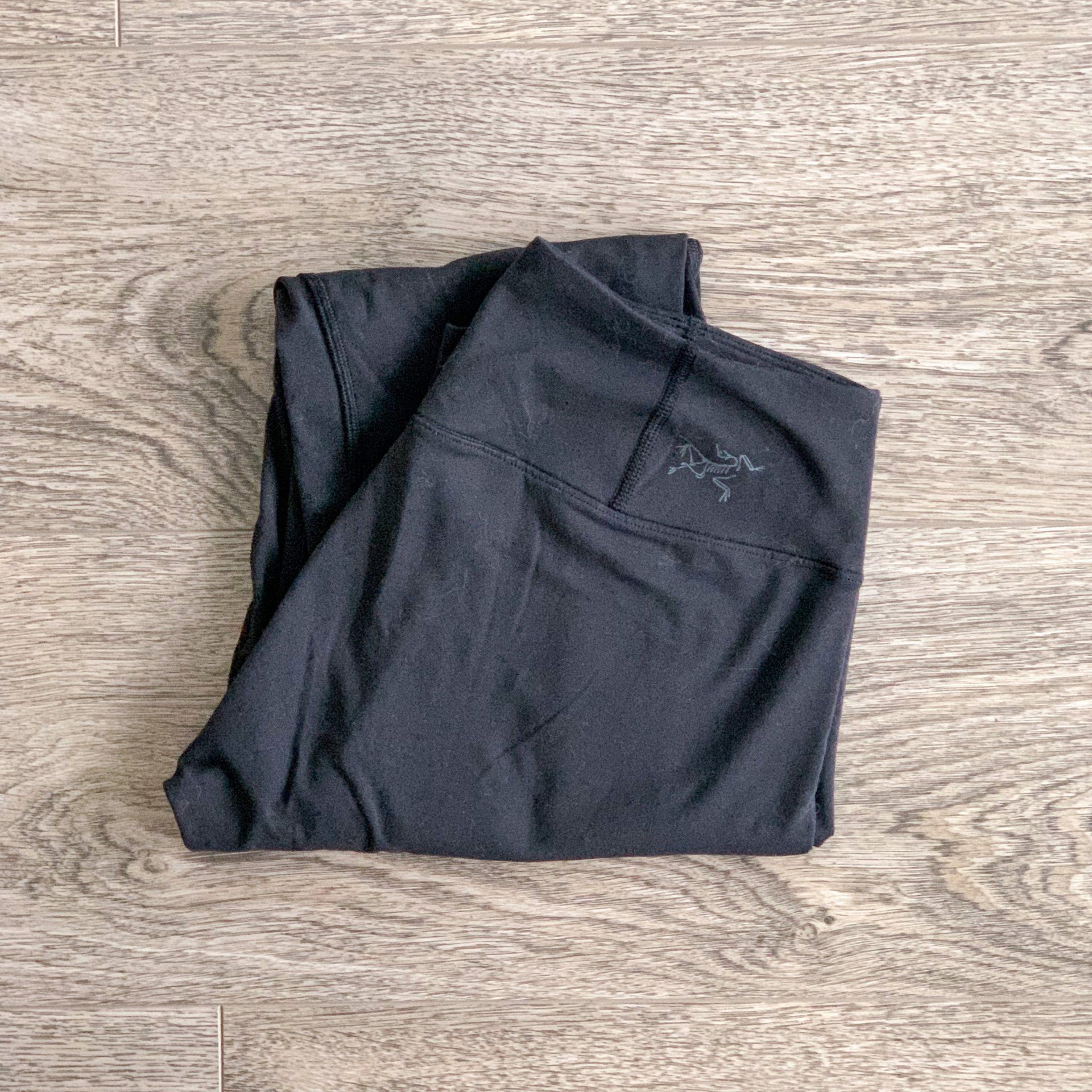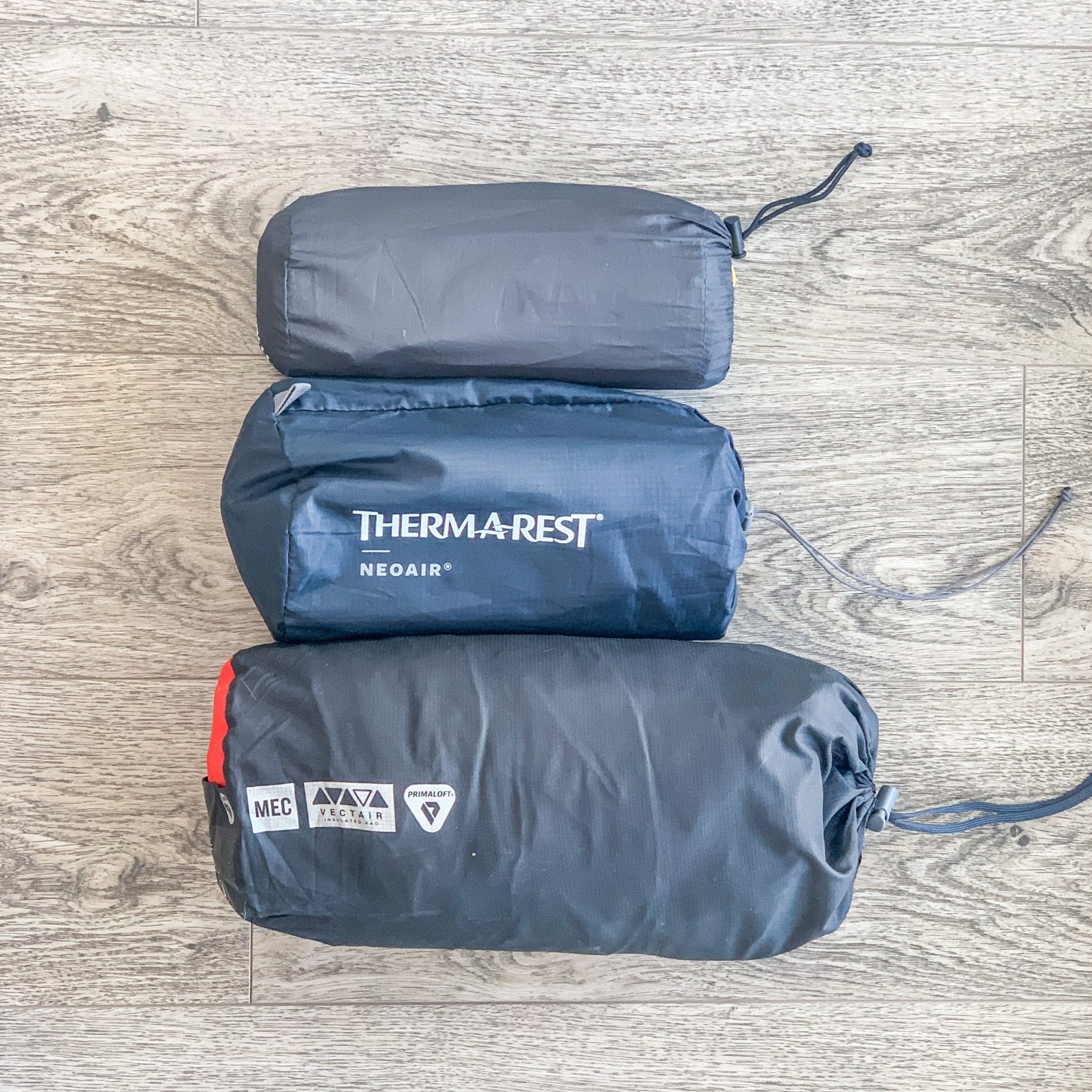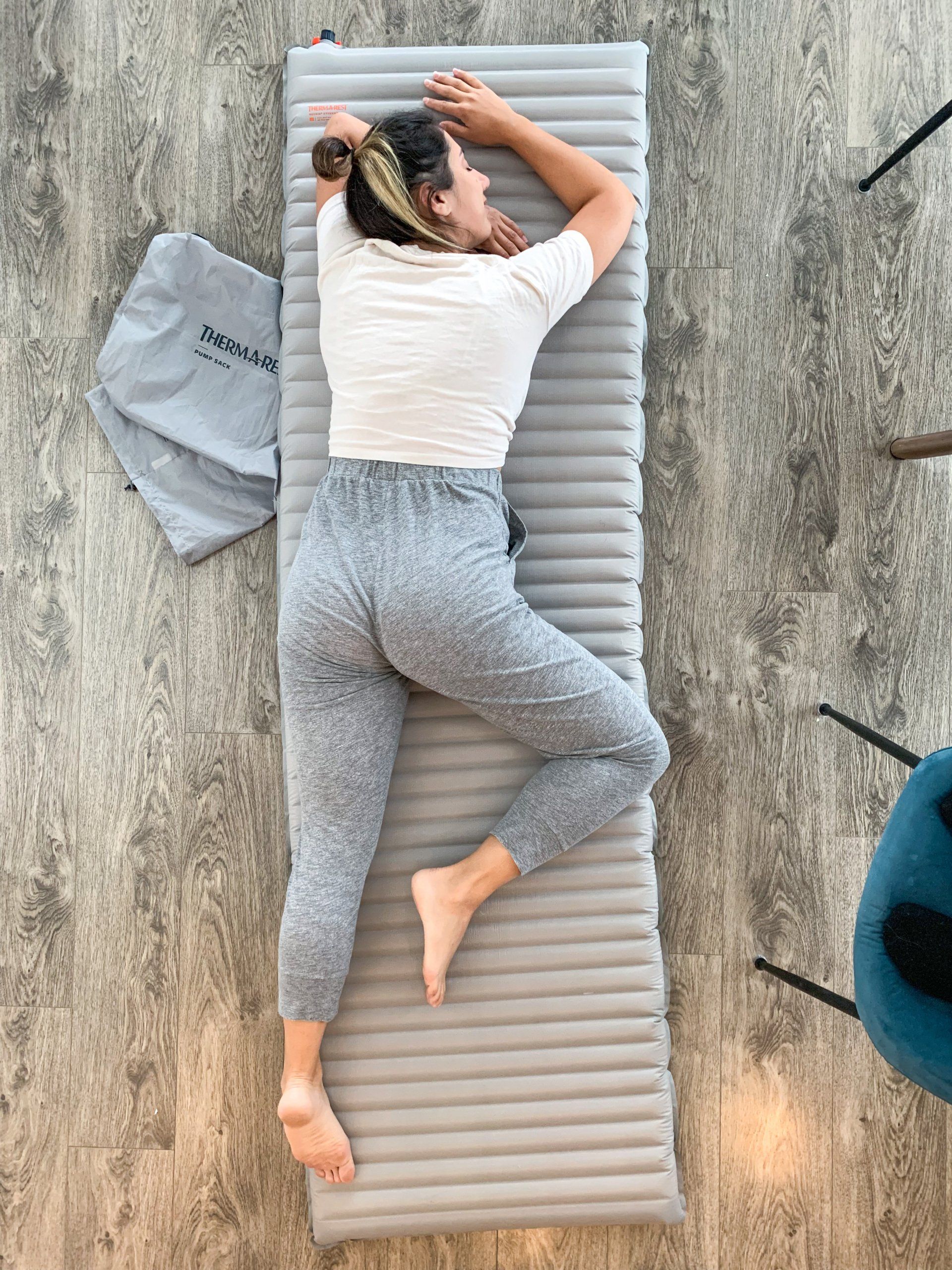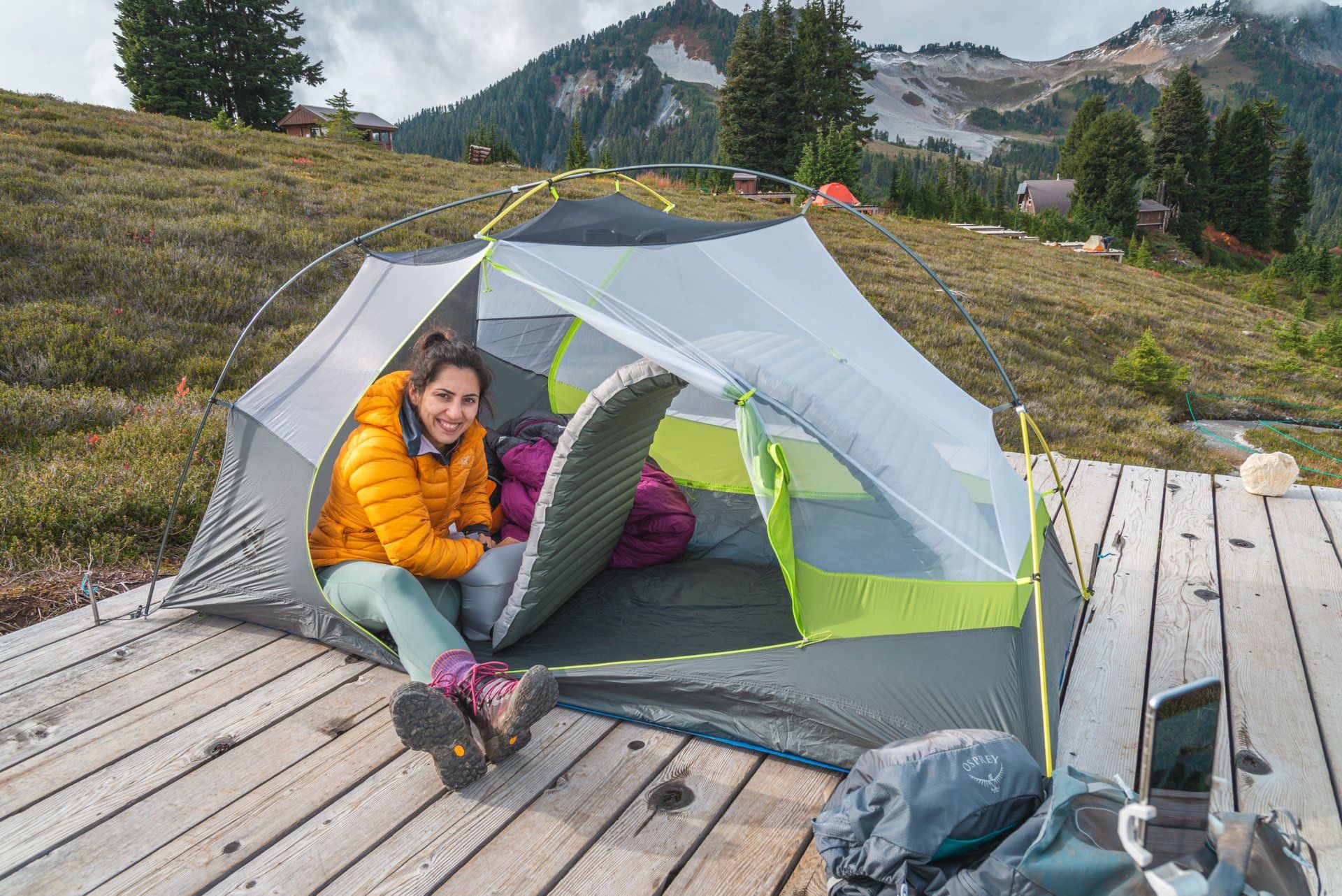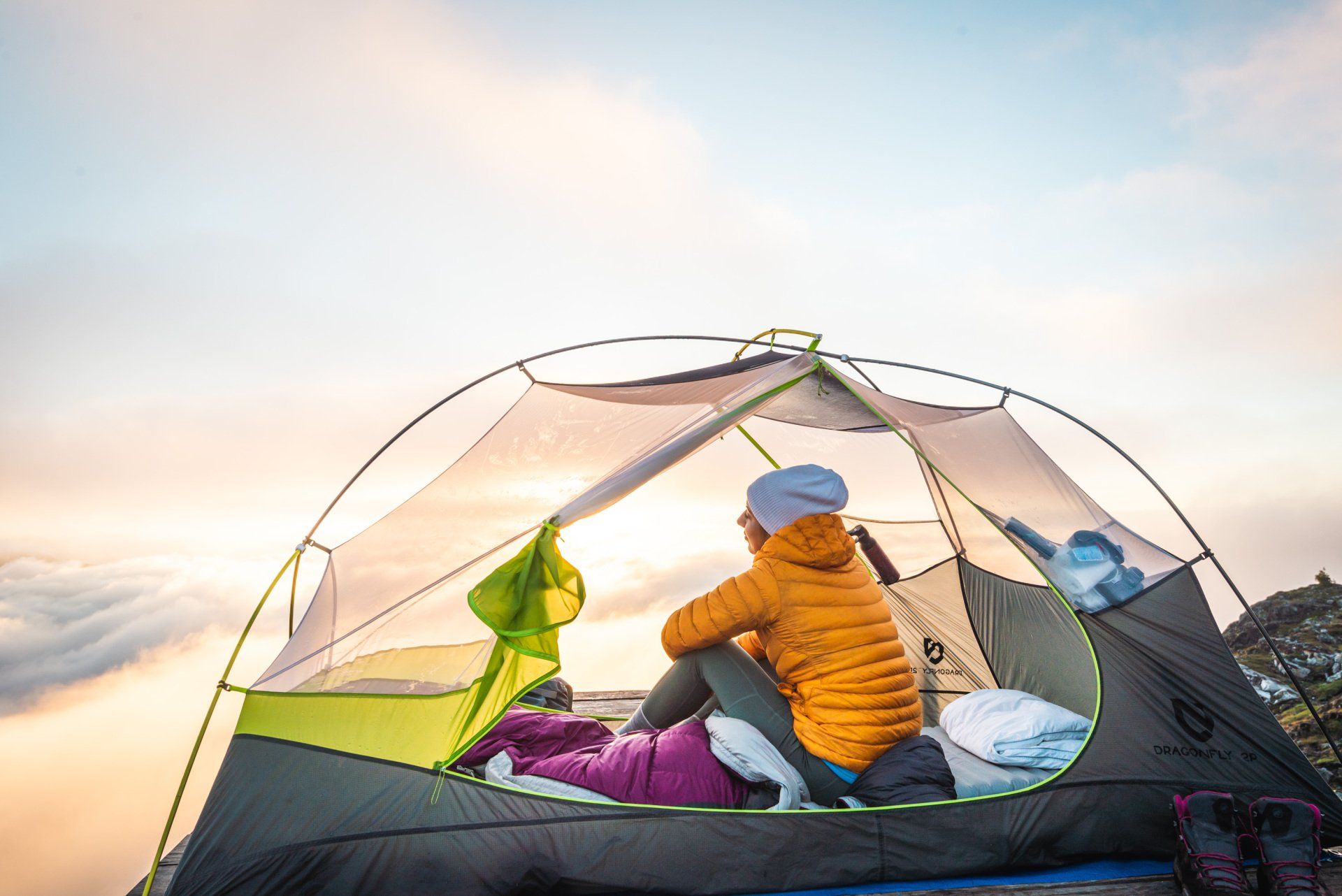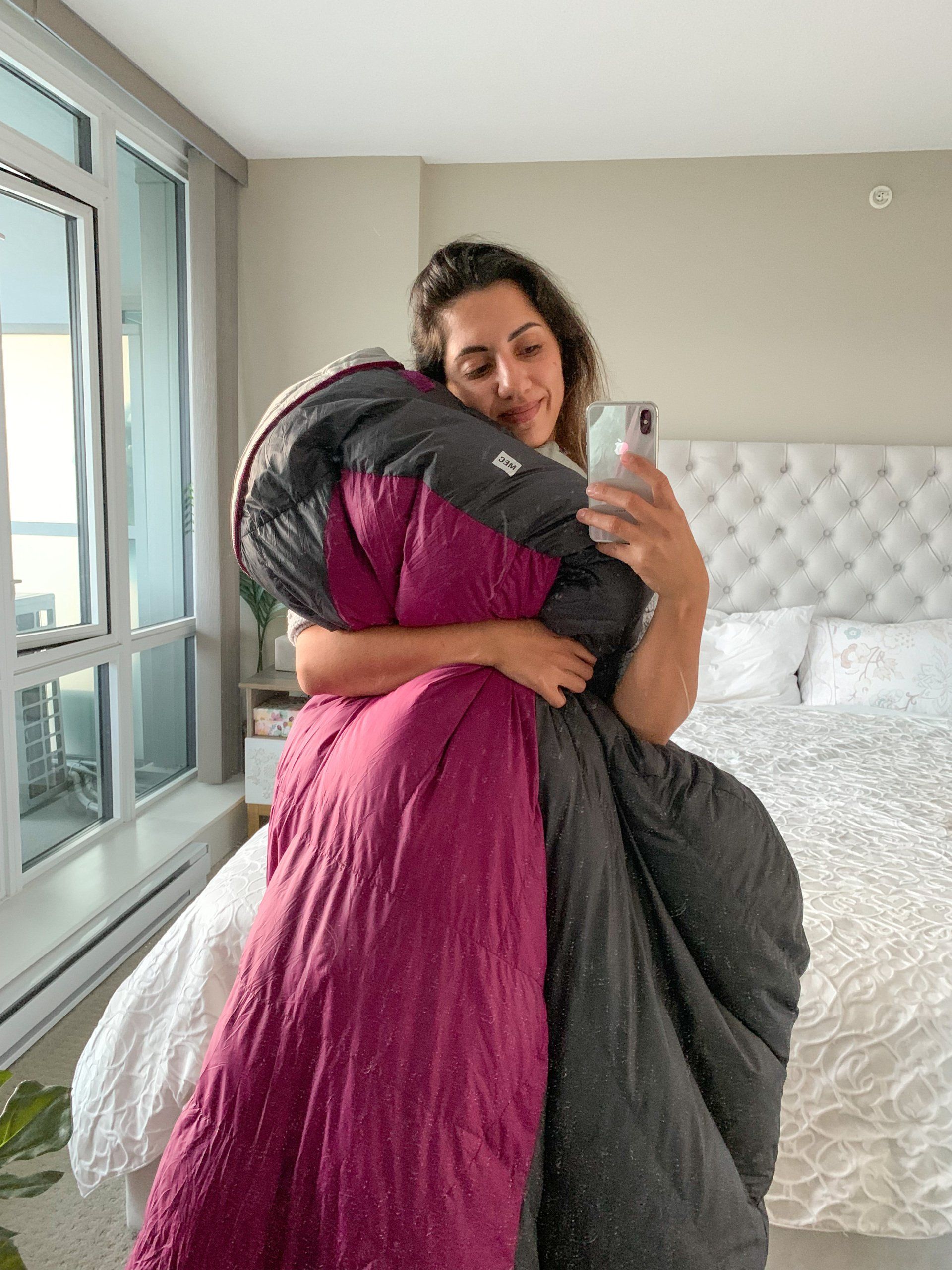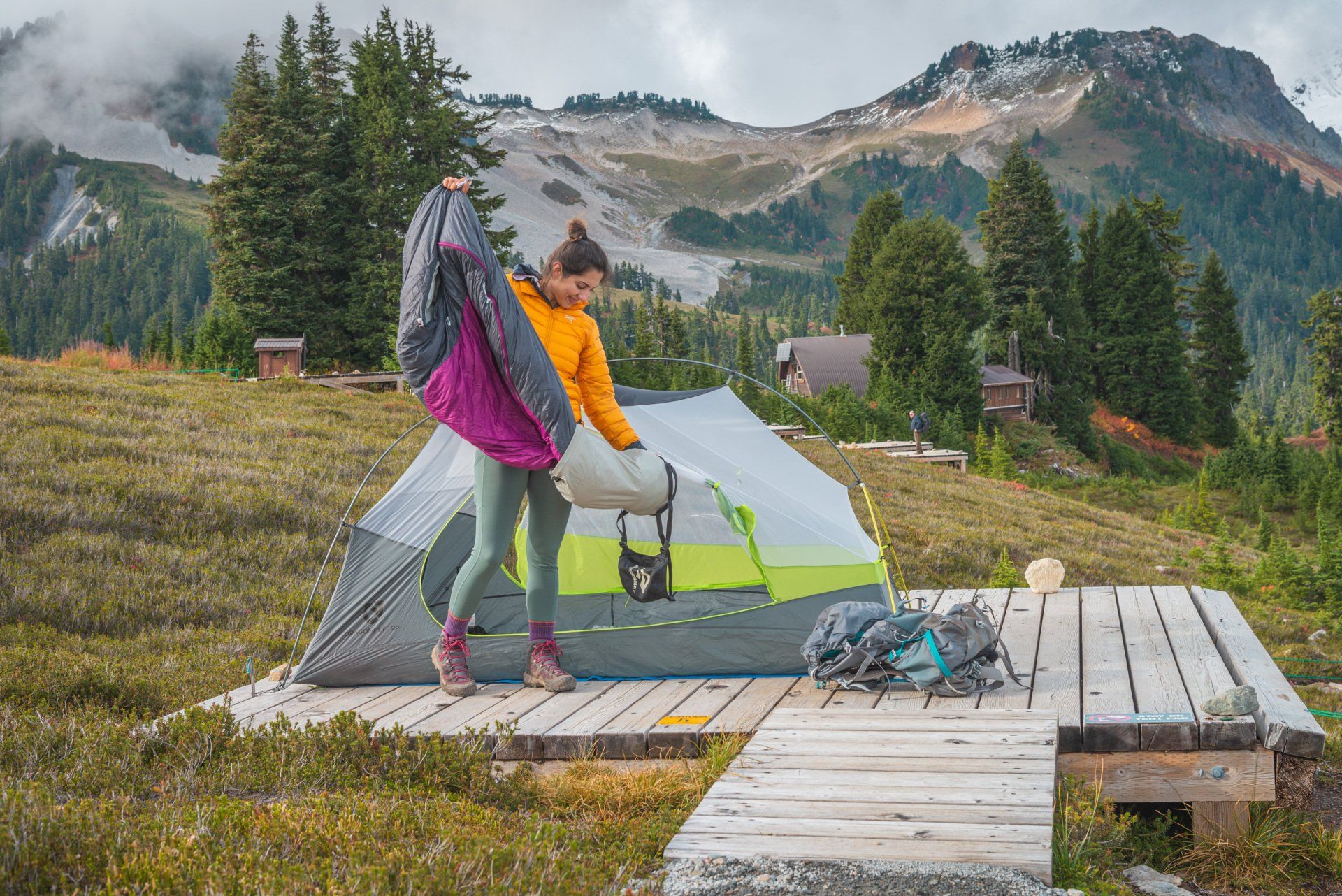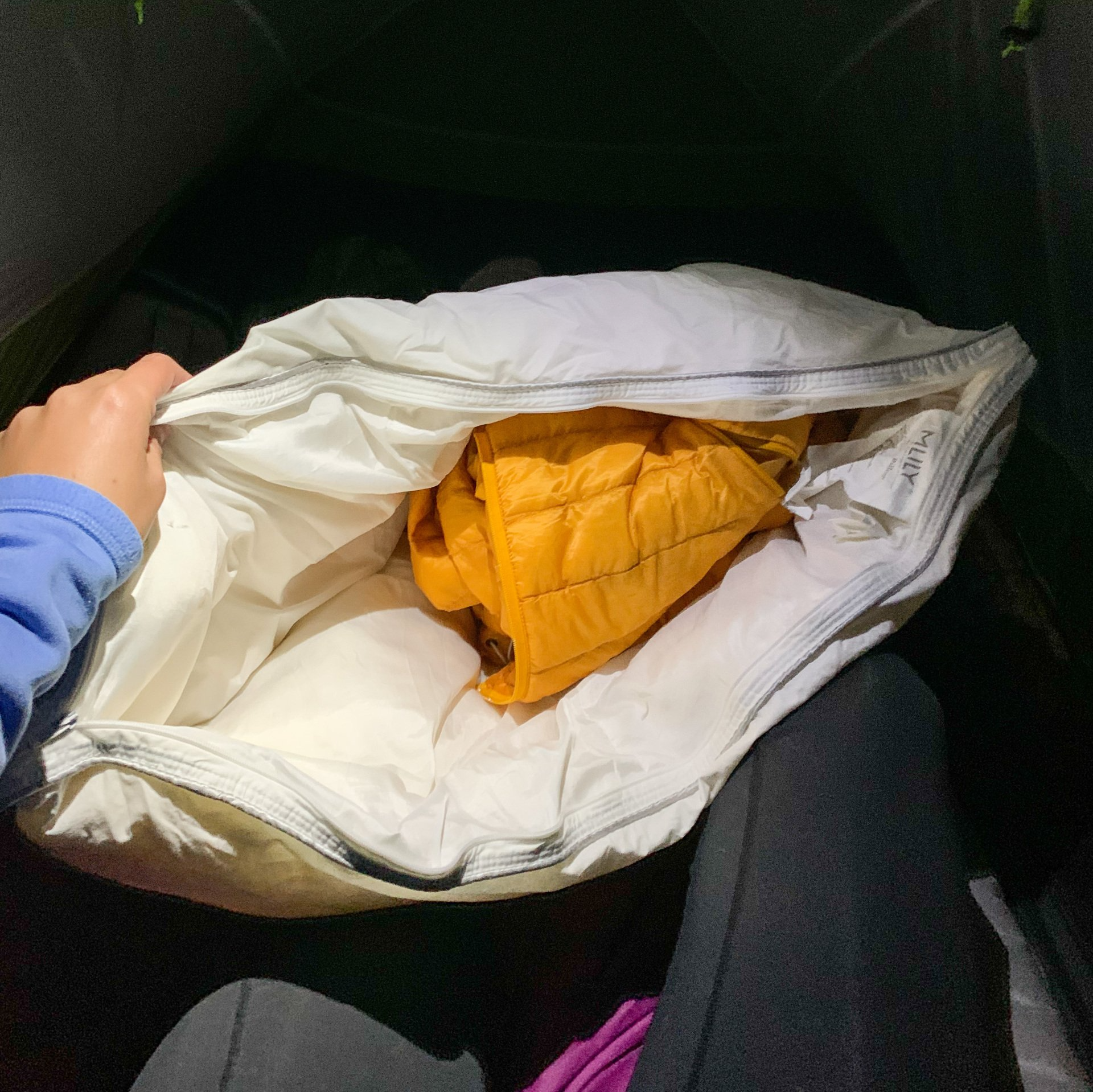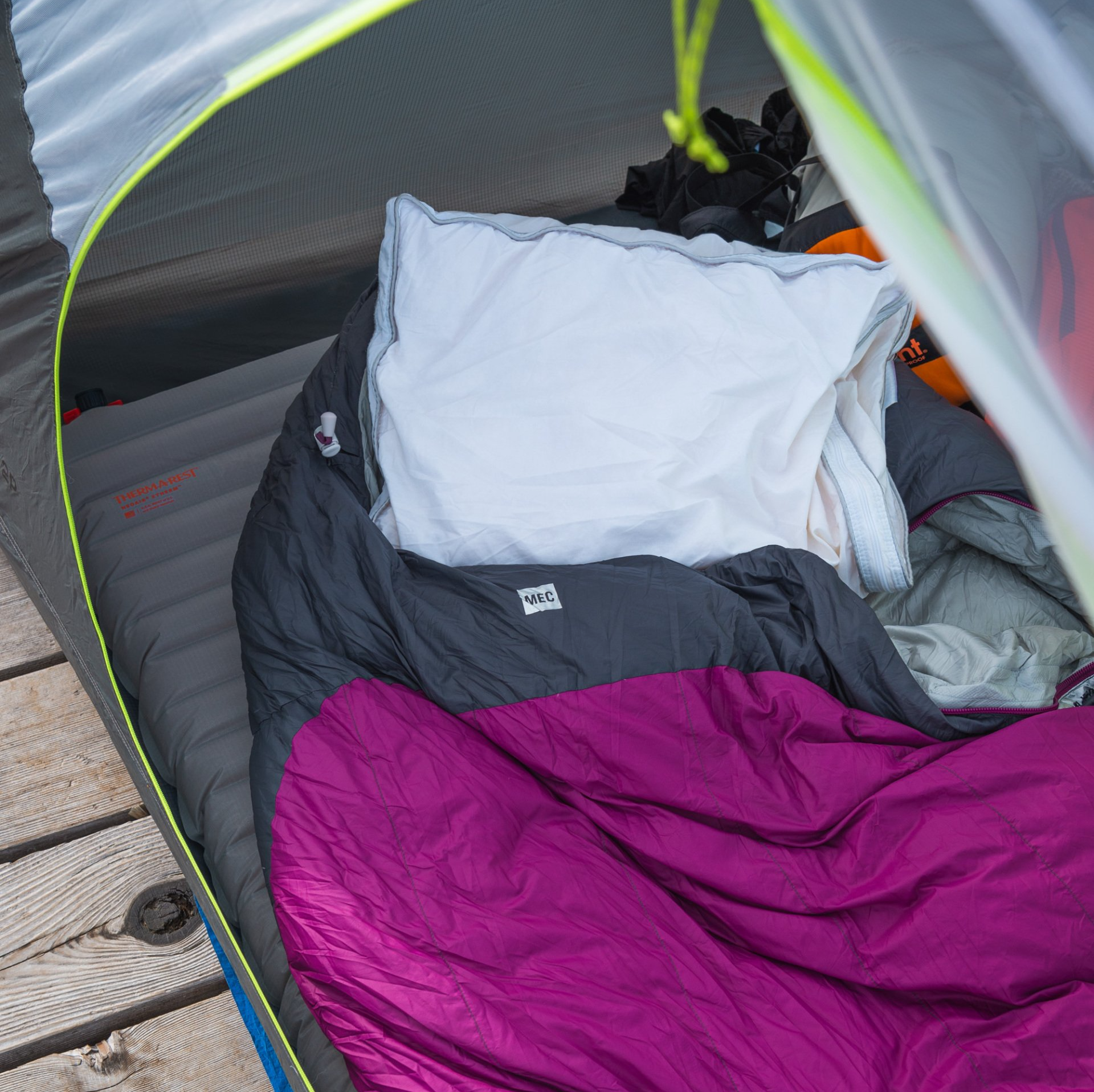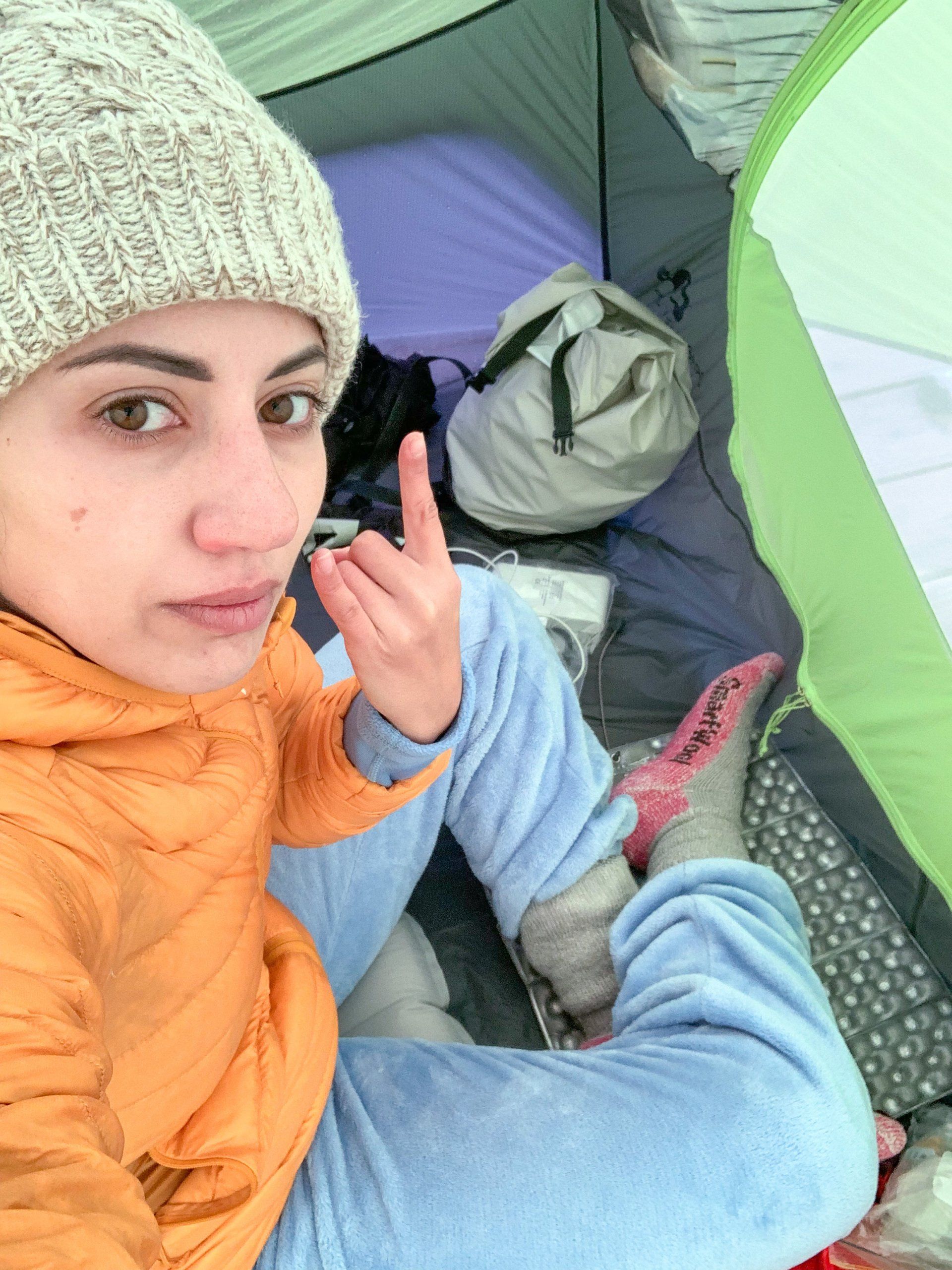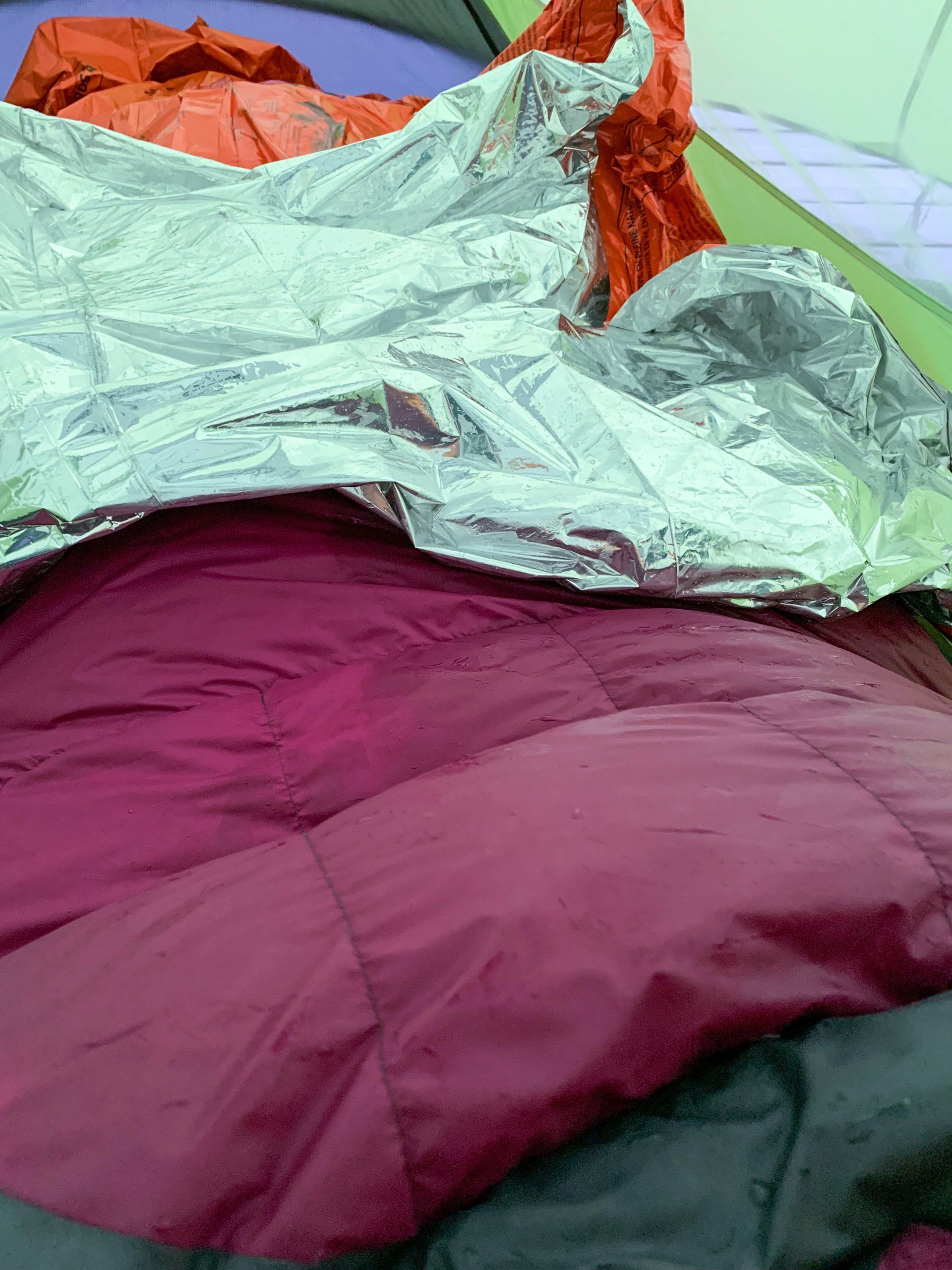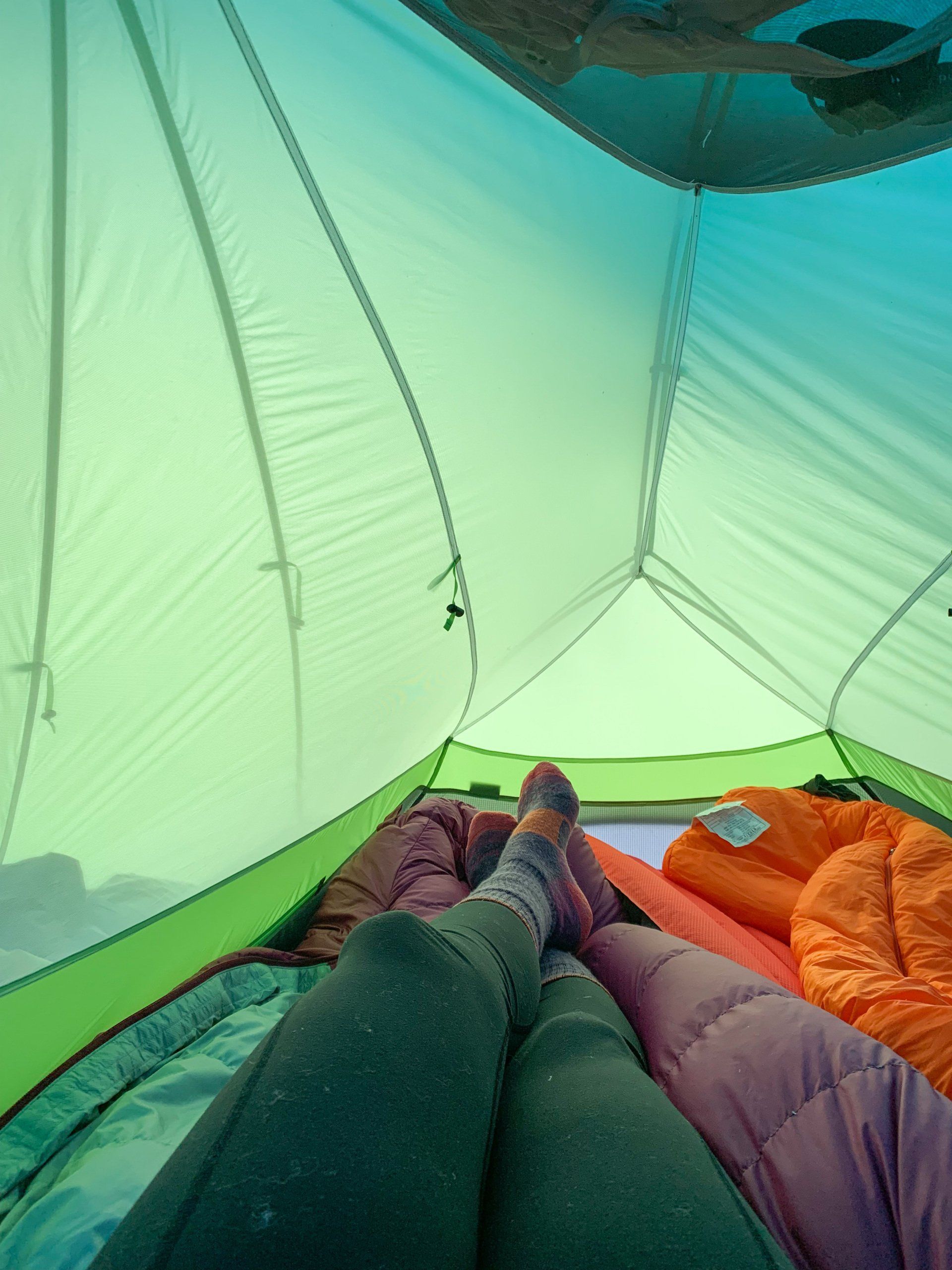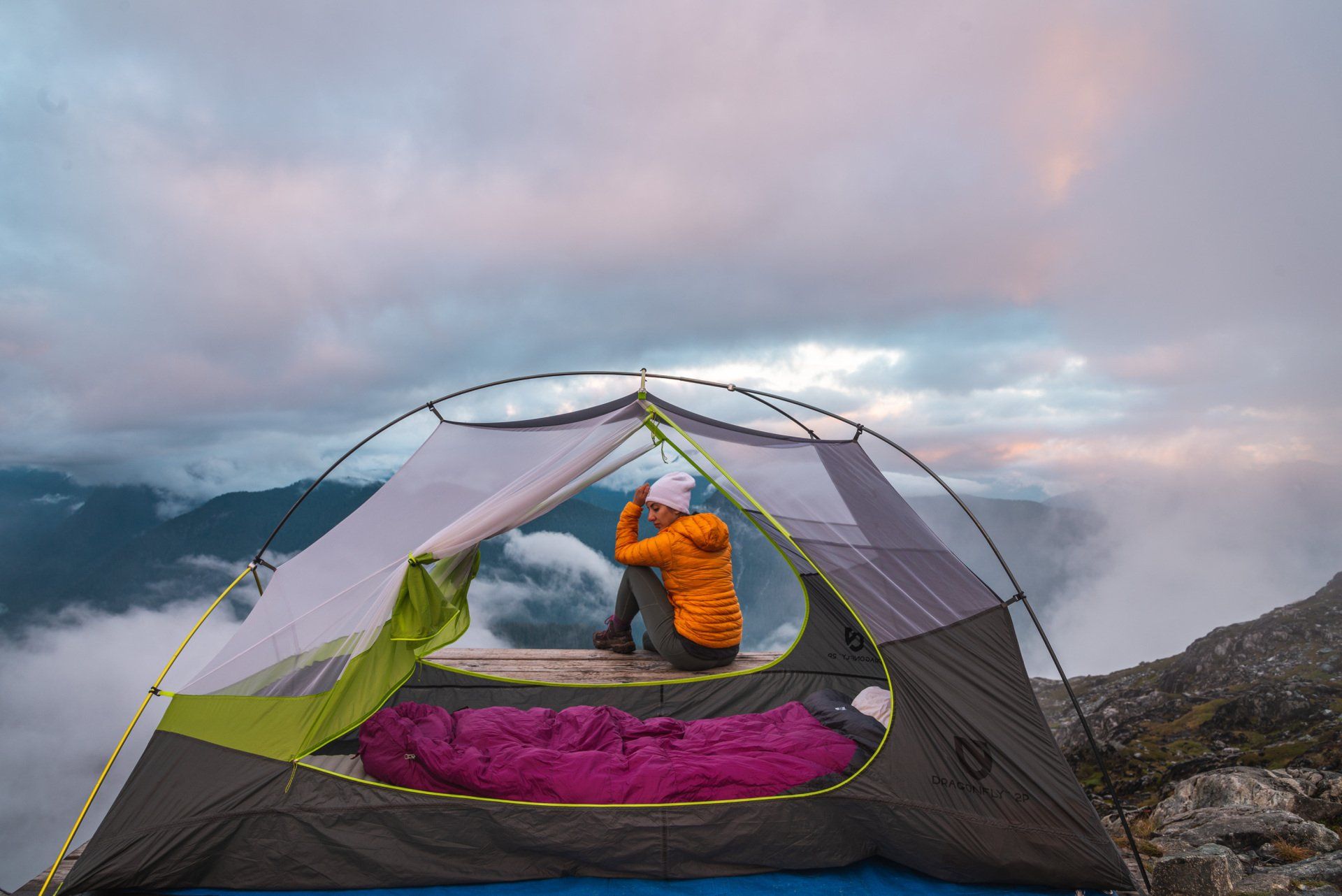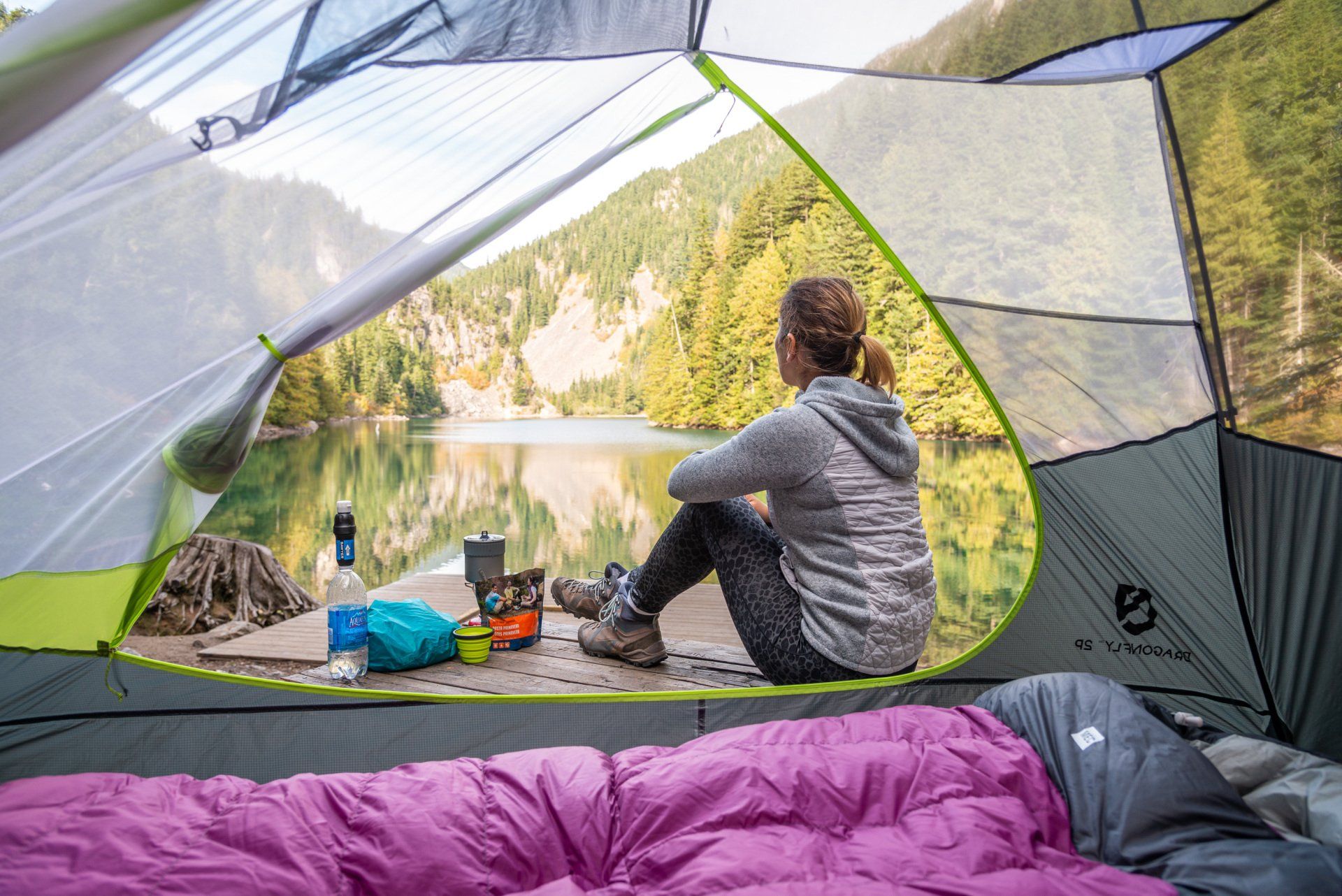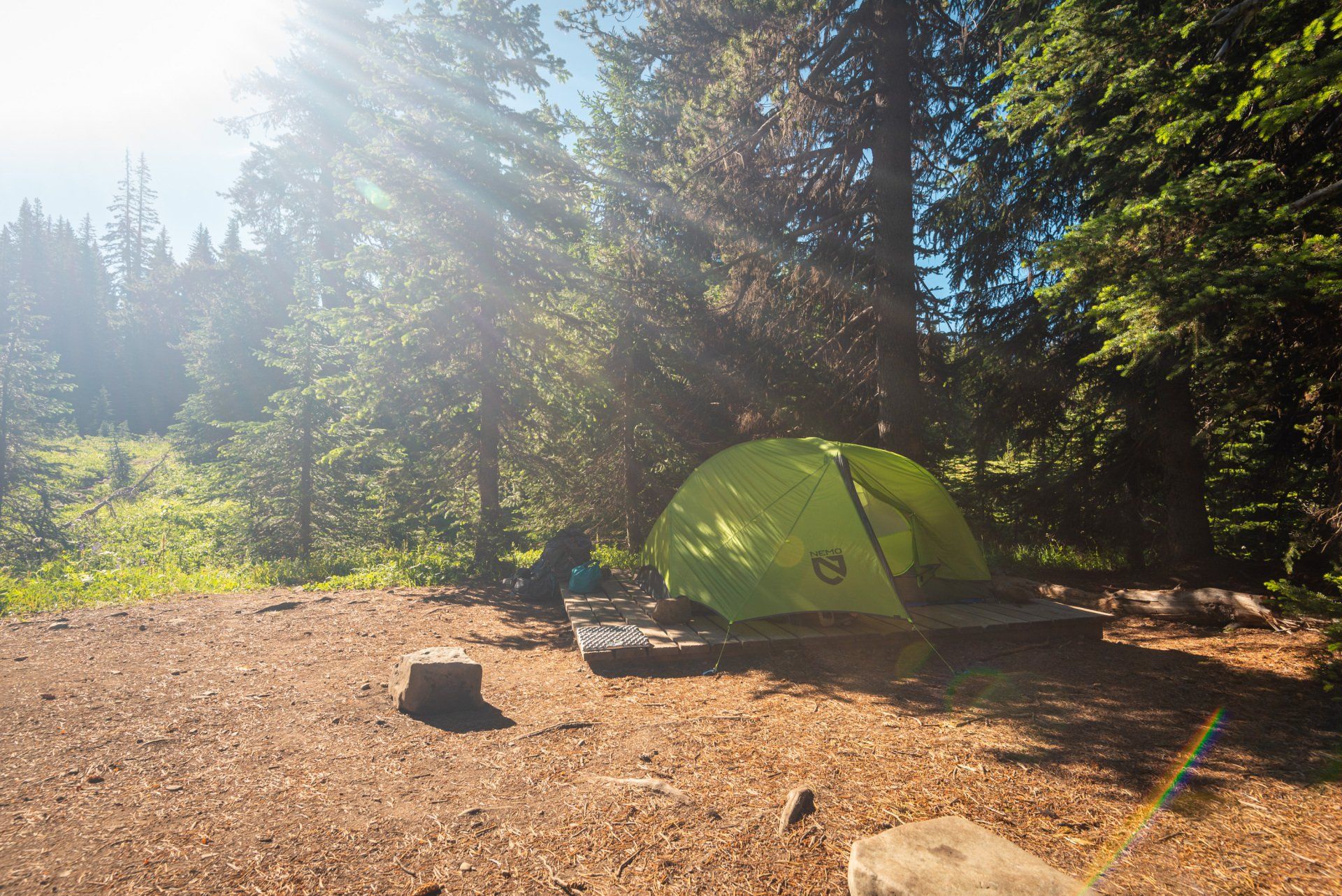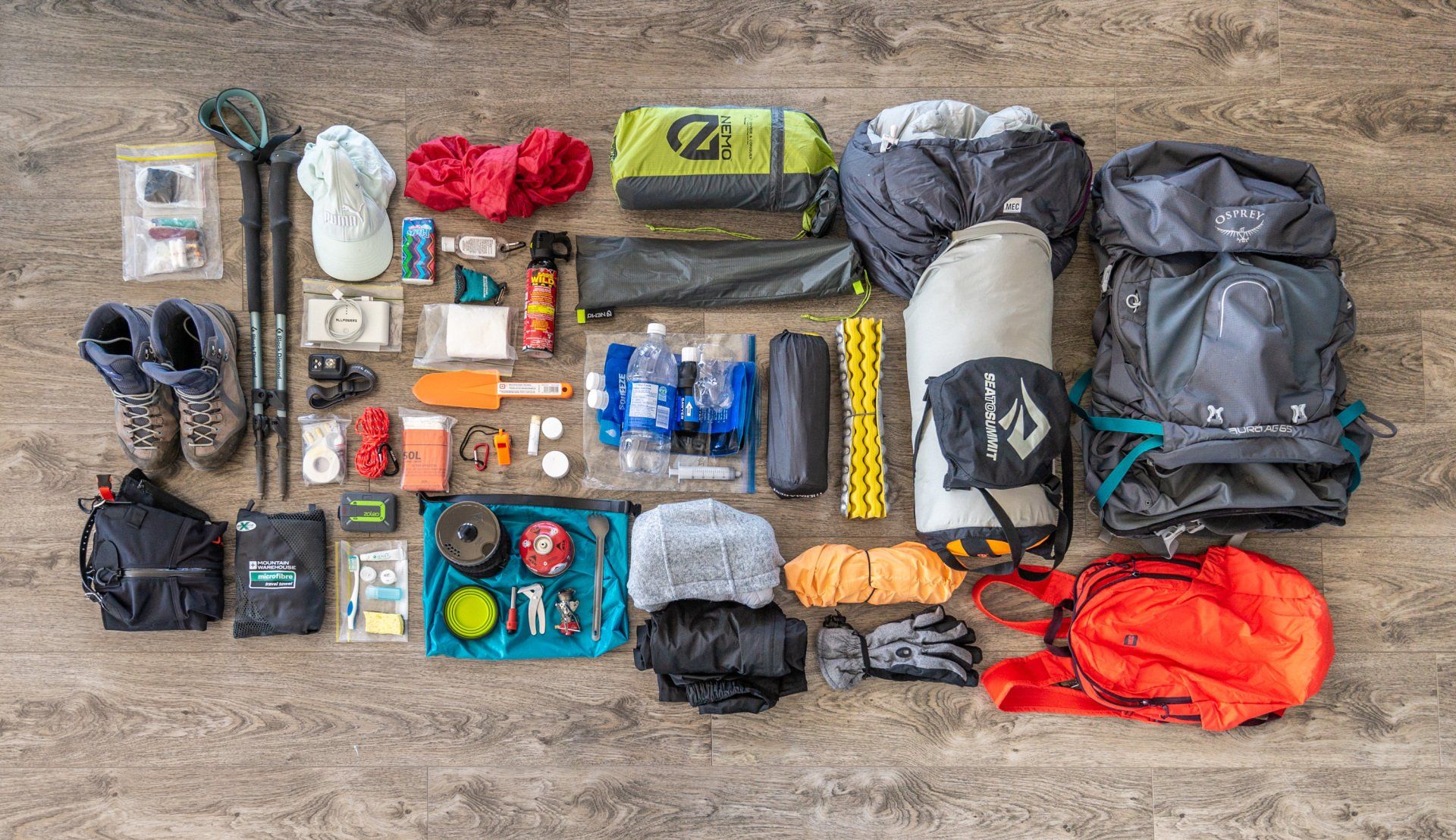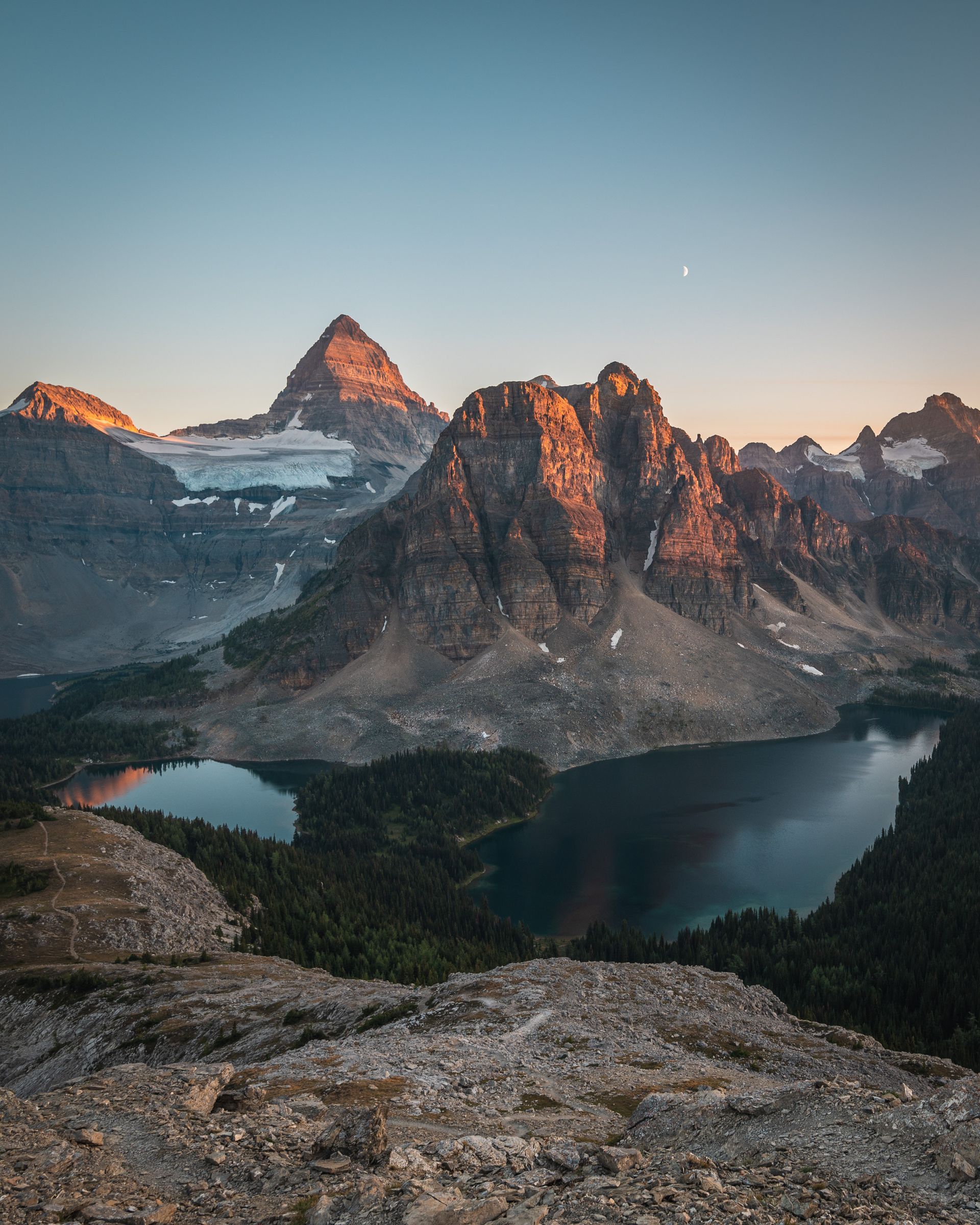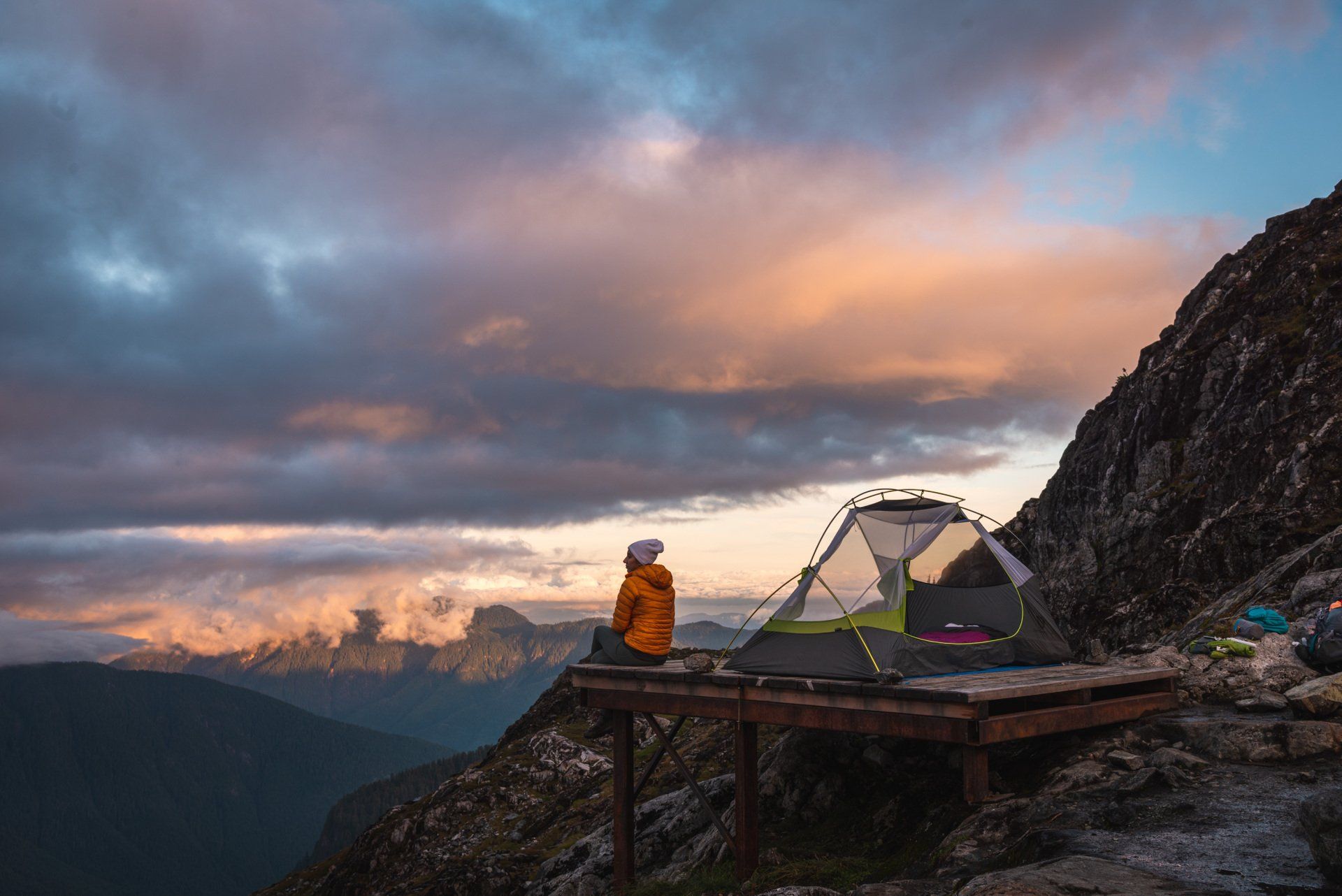My sleeping system doesn’t suck anymore
Getting a good night’s sleep is an important part of an enjoyable adventure, especially where physical challenges are involved. My sleeping system was a bit off last year, and after testing my upgrades for 10 nights on different trips this season I’m happy to report it’s much better!
My 2021 gear
Here’s what my sleeping system looks like these days:
The major change
One of the main problems last year was that I wasn’t comfortable in my field bed. This spring, I’ve tried to lay down on my husband’s sleeping pad at home and it clicked with me. His MEC VectAir (the link is to an upgraded version) was so soft and comfy and felt like a king size bed comparing to my tiny Therm-A-Rest NeoAir Xlite Women’s.
I was thinking of taking his pad to the Berg lake trail, but since it’s pretty bulky and heavy (1.22kg vs 340g of my Xlite) I’ve decided to spend my b-day present 😅 on a new sleeping pad.
The one I’ve got is Therm-A-Rest XTherm Max. Size large 😂 Guys, it’s 2 meters long and 64cm wide. It’s a damn king size bed 🤣 For reference, I’m 160 cm tall! Also its R-value is 6.9 which is expedition grade, they say. It weights 640g and its packed dimensions are 28 x 11 cm. It’s much bulkier than my old Xlite, but also much more compact and light than the MEC VectAir.
The sleeping pad change has made a major difference to my experience, and here’s the reason why: I’m a tummy sleeper and literally had my limbs hanging off of the small Xlite. I was cold (at times) and uncomfortable.
Take a look at the difference, photos courtesy of my mom 🥰:
The new XTherm is long enough to accommodate my arms position above the head and almost wide enough for my bent leg, so it’s much better built for my natural sleeping pose which results in an increased comfort.
More about the pad and things to consider
The specs:
- Weight: 640g
- Packed dimensions: 28 cm x 11 cm
- Inflated dimensions: 64 x 196 cm
- R-value: 6.9
- It has a pump sack which I can say is so much better than inflating with your mouth and surprisingly fast, too! Saves me getting dizzy and I know I’m not introducing moisture inside the pad.
- It has the wing lock thing which is very convenient - it doesn’t let the air out while inflating and deflates a bit faster than my Xlite.
Stuff to notice:
- Since it is as long and wide as MEC VectAir, when Stephan is in the tent with me, the mattresses don’t fit side by side in my Dragonfly 2P tent - it’s probably built to fit 2 tapered pads - while ours are rectangular. So they kind of overlap, but it somehow works. It does trigger my OCD 😅 but not an issue in reality - at least for us.
- It is still an inflatable pad and air is all that supports you. I still get back pain if lie on the back and still wake up with my body aching. Yep… But - I do fall asleep faster and sleep better still. I’m fine with the weight-to-comport compromise at this point.
- It is noisy - much louder than MEC VectAir - but I don’t care and Stephan doesn’t care, too. So we’re good. Also I wouldn’t say the noise is SO bad.
I’ve spent 11 nights in the tent this summer, 10 of them on the new XTherm and I can tell I sleep much better than the last year. I’m much more comfortable, it feels much more like a real bed 😁 and overall this was moneyzz well spent for me.
Conclusions regarding the sleeping bag
In the previous sleeping system review I’ve mentioned I’m not sure that the mummy shape of my MEC Delphinus -9C sleeping bag was the right choice for me. After 11 more nights spent sleeping outdoors these are my thoughts:
So I think since I’m a tummy sleeper, not only the shape, but also the size of this bag is a problem. As you can see on the pic of me laying on a sleeping pad, the shape of my sleeping body is longer than my actual height. I got the sleeping bag based on my height - and it is a bit too short for me to comfortably extend my arms and toes. Also yes, it’s a bit narrow for extending my leg to the side the way it would be comfortable for me.
So a conclusion - if you’re a tummy sleeper - take the actual shape you tend to sleep in into account before choosing a sleeping bag.
On the flip side though - unused bag space IS a problem when it’s cold. I’ll be talking about warmth a bit below.
But overall, after switching the sleeping pad I feel the sleeping bag is not that much of an issue, so I’m not sure if I’m going to replace it in the near future. It’s still warm and cozy and I do enjoy mine. But If you’re looking into buying your first one - def take this advice into account.
The pillow
Still using the same down pillow cover - but since I got my Arc’teryx Cerium LT puffy jacket, I tuck it inside for the night if not wearing it and then my pillow feels oh, so luxurious and comfy! This (obvious) life hack has greatly improved my time of falling asleep, since the down pillow really feels like home.
I still need to make a pillow case 🙄 I do find this pillow thing, becomes messy throughout the night and wakes me up.
Fun fact - had a short chat with another couple camping at Elfin lakes on my last trip - and they said with kind of an embarrassment that they bring pillows while backpacking as they love comfort. Well, I don’t think getting a decent sleep while backpacking is a luxury. I think it’s a necessity and nothing to be embarrassed about. Even if it was for luxury… On my last trip I brought a chair and a hat with a pompom instead of a lightweight beanie and my backpack weighted 23kg 😂 so what?
My sleeping clothes
My field pajamas have changed quite a bit - I have mentioned the Arc’teryx Rho LT leggings in the previous sleeping system blog post, but also added new socks and a new top - Smartwool Mountaineering socks and Arc’teryx Rho AR zip neck. I also sleep in my Arc’teryx Cerium LT down jacket when it’s really cold.
I’m the happiest with the Rho AR long sleeve - its material is sooo cozy and soft! On the outside it’s a bit sleek so doesn’t catch my cats’ hair and it fits so damn well on the body. It’s warm and I love it beyond using as a sleeping base layer - I wear it a lot. So I would say it’s no less warm than my Mountain Warehouse long sleeve, but fits snug and doesn’t move on the body so much - and also, is breathable, so I didn’t really find myself sweating in it despite this summer was warmer than last year.
For the Rho LT leggings - I do love them too, but I find for the most part it still takes quite a bit of time for my butt to get warm. It has happened on nights of about 7°C and below, otherwise I was toasty.
I do love these leggings for hiking on a more chill weather and wish they had pockets (!!!Companies, we need pockets!!!) and the material wouldn’t attract all the cat fur and down feathers along the way. I would be looking into getting warmer tights for sleep though.
The Smartwool Mountaineering socks - they are much better than what I had before - warm and cozy. And although there are still times that it takes some time for my feet to get warm, I feel like it is as warm as it gets when it comes to socks - they are really thick and fluffy and made of 74% Merino wool (not itchy one bit!). They have good breathability, too.
The Arc’teryx Cerium LT down jacket has been great overall, and specifically for sleeping - too. It’s a great addition for the colder nights. I like that its shape is also so nice on the body - it’s snug but at the same time accommodates layers. So it doesn’t move around while you sleep.
I’m pretty happy with my updates to the sleeping base layers, and though there is still room for improvement, they do greatly contribute to my comfort while sleeping in the tent.
Do you need these expensive base layers just for sleeping? Probably, I’d really recommend investing in wool socks anyway because I’m not sure you can find a synthetic alternative. For the other pieces - if it’s just to act as your field PJs, I wouldn’t invest that much. But I do use these pieces besides just sleeping in them and can say they are amazing, so for me it was worth the investment.
Warmth wise
Here’s an overview of how my upgraded sleeping system performed in some higher and lower temps during my nights in the backcountry (and front country).
So for the low temps, my coldest overnights this year were at the Elfin lakes campground. Funny as I have opened and closed the season by camping at the same location. The first one was at the end of May, still 1-2 meters of snow and the temps at night were slightly below freezing - the slushy snow became frozen over night. And the last time according to my Zoleo app weather forecast it was 2°C at night on October 1st.
Both times I have slept with the puffy jacket and a hat on. Last time also with my gloves on. First time I was with my old Xlite, this time - with the XTherm. What can I say, I was a bit cold both times 😅 the upgraded sleeping pad didn’t help much…
Maybe there was a difference in humidity or honestly I’ve no idea.
Anyway, seems like this sleeping system even with the new expedition grade sleeping pad (R-value 6.9 vs 3.9 of Xlite) is good for up to around 0°C.
The last time at Elfin lakes I couldn’t get warm so I figured maybe cover the sleeping bag with an emergency blanket - the thin plastic ones that are supposed to help you retaining heat in emergency. DON’T do that! 😅😅😅 Idk if it has even helped, but in the morning I realized the inside of the blanket and the sleeping bag beneath it were wet! It turns out moisture is evaporating through the sleeping bag. It’s not my breath as the blanket was somewhere around the chest level. The tent was remarkably dry from the inside though 😅 so I guess the blanket took on all the condensation. Weird. But I’ve tried so you don’t have to 😂
Also, this last time at the Elfin lakes I’ve tried to hold plank for 20 secs in my sleeping bag 😅 I think it has somewhat worked. But I get hot very quickly while exercising, might not be the same for you.
Another thought I had regarding the low temperatures is that maybe there’s just a limit of how fast my body can produce heat and thus how fast it can get its surroundings warm. And maybe at this point no matter how much insulation I have, if the materials are cold, I’ll need to warm them up with my body. So maybe I have to consider an external heat source like a water bottle filled with hot water. Need to look into this further.
Now, for the higher temperatures.
So the warmest I have camped this season is somewhere around 10°C. Surprising considering how hot the 2021 summer was here in BC, right?!
Anyway. I was a bit hot at times - especially while spending nights in tent with Stephan and even made an attempt to sleep without the base layers 🙄 but what I found is a- my body ended up kinda sticking to the sleeping bag - ew 😅 and b- I couldn’t really uncover myself cause it was pretty freezing outside the sleeping bag still.
But having my base layers on (including the mountaineering socks haha) during the rest of the nights I was much more comfortable - didn’t feel the sweat and also could move the top of the sleeping bag a bit away and let myself cool down a without freezing myself.
And another thought - I find the warmth does depend on whether you’re sharing a tent with a partner or no. Might seem obvious, but don’t forget to take it into account if you’re used to camping with a partner but preparing to head on a solo adventure.
So in conclusion, this sleeping system works pretty well for me in the range between 12°C (10 degrees minus Stephan 😂) and 0°C, needing some external heat source at the lower end for ultimate comfort and running a tad hot at the higher end while sharing the tent with a partner. Suits perfectly for summer mountain backpacking adventures in British Columbia and the Rockies and might be good for shoulder seasons, too.
Again, for reference, I’m a female, 160cm high, weight 61kg, not a cold sleeper, maybe a tiny bit of a hot sleeper.
Digestion stuff
In my last sleeping system overview I have mentioned the digestion related issues with my sleep - my body seeking relief 😅😅. So I’m trying to stick to my own advice and eat supper early. Usually these backpacking meals fill me so well that I’m really not hungry till I go to sleep.
It does work ok, better than it was in the beginning of my backpacking journey, so I’m pretty happy with the situation for now.
The fear
I’m happy to report that the fear of sleeping in a tent and sleeping in a tent alone - which was more of an issue while I just started backpacking, now has gone almost completely.
To date, over 2 seasons, I have spent 17 nights at the backcountry, 9 of them solo and as I do it more, I do feel more and more comfortable.
So to summarize, my backcountry sleep has improved this season and I’m very happy! Let me know any questions you have! I can talk about backpacking for hours 😂
And if you’re interested in what other gear I use, make sure to check out the What’s in my backpack blog post.
Cheers,
Oless
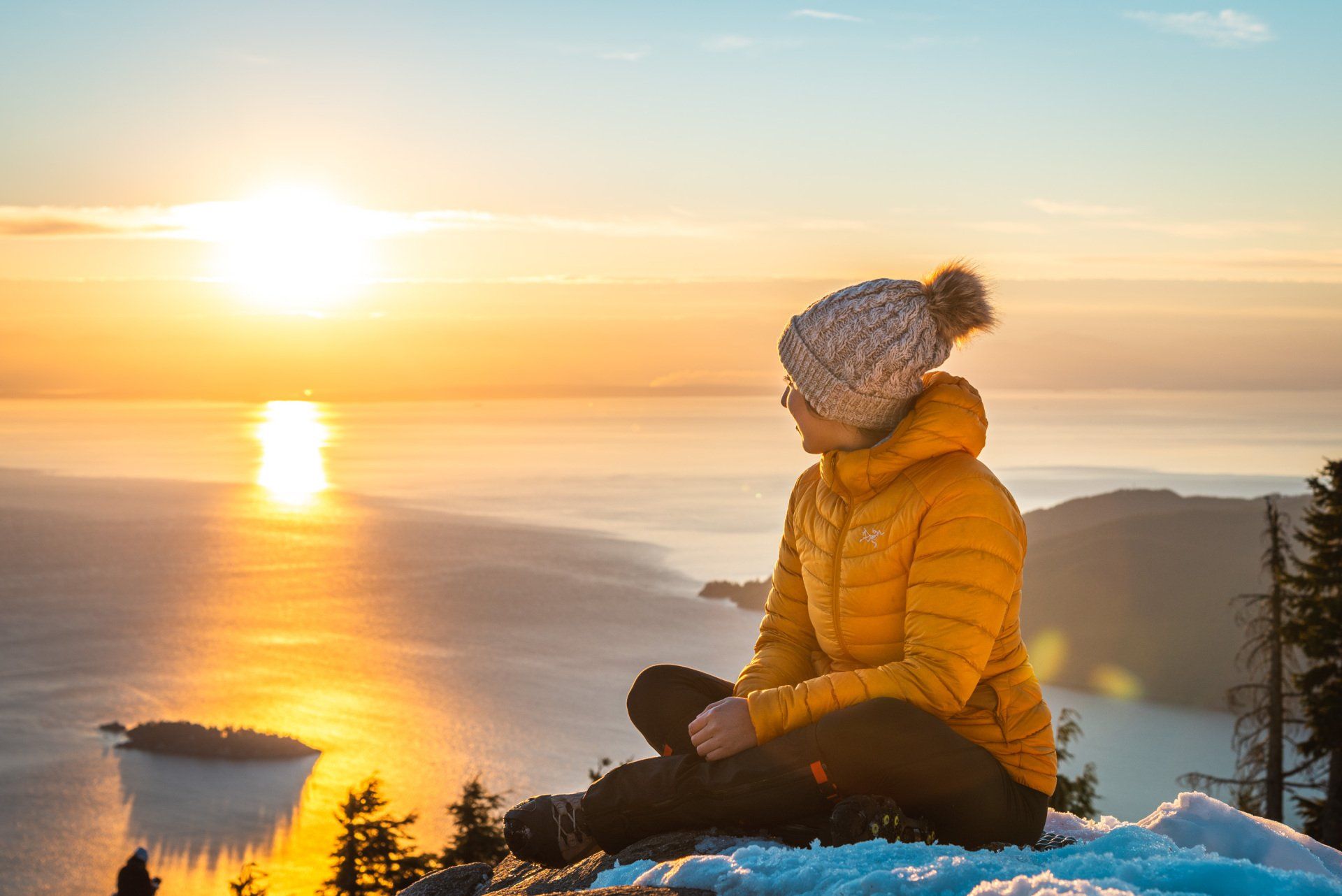
Follow my journey on the instagram!


